
Covid-19
What is Virus?
Cat: SCI
Pub: 2020
#2004
Compiled by Kanzo Kobayashi
20303u
Title
What is Virus?
ウイルスあれこれ
Index
Tag
; Abiogenesis; ATP; Baltimore classification; Capsid; CDC; ECMO; Genetic code; Kinase; Large DNA virus; Lysis; Lysogenic cycle; Lytic cycle; Medusavirus; N95 mask; Phosphorylation; Photophosphorylation; Protein world; Ribosome; Rickettsia; RNA world; Self-assembly; Size of Virus; Structure of Virus; Viral entry; Viral eukaryogenesis; Viral replication; Virion; Viroid;
Original resume
Remarks
>Top 0. Preface:
- The most important news proliferated in the beginning of 2020: epidemic Coronavirus
- It worth to understand the essence of viruses this time, rather than enforced daily care of not being infected by the virus.
- Actually viruses have long history in its evolution: how they survived on Earth?
- Etymology of Virus: <L. virus, slimy liquid poison; the spelling of virus is common among Latin, Italian, Spanish, French, German, and English.
- Some viruses are poisonous but some are not; whose origins are much older than animals, and have played important functions in the evolution of life.
- Civilization has functioned as a cradle of infection; most of infections never happed in the hunting-gathering era. Infection need to a scale of city of several hundred thousand population after agriculture era.
- There are many infections are considered to be derived via animals; measles from dogs, smallpox from cows or camels, influenza from ducks, etc.
- The present viruses are more activated by frequent movement of people and globalization.
1. 序文:
- virus: < contagium vivum fluidm, contagious infecting substance with life
- コロナウイルス伝播問題
- ウイルスについて学ぶ
>Top 1. Wikipedia describes:
- Virus: small (10-100nm; 1/100 of most bacteria) infectious agent, replicates only inside the living cell, and infect animals, plants, and microorganisms.
- In 1892, Dimetria Venosity described virus, and in 1898 Martinus Beijerinck discovered tobacco mosaic virus; nos 5,000 virus species have been described.
- Viruses exist in the form of virus, consisting of 1) genetic material (RNA or DNA), 2) capsid, or protein coat, and in some cases 3) outside envelope of lipids.
- the shapes range from helical and icosahedral forms.
- In evolution, viruses:
- are considered to evolved from plasmids or bacteria.
- the origin is unclear because of not forming fossils.
- spread by horizontal gene transfer, increasing genetic diversity in a way analogous to sexual reproduction.
- transmit from plant to plant by insects, or in animals by blood-sucking insects.
- influenza viruses by coughing and sneezing.
- norovirus and rotavirus by contact of faecal-oral route.
- HIV by sexual contact or exposure to infect blood.
- Viral infections in animals provoke an immune response that usually eliminates the infecting virus.
- vaccines: artificially acquired immunity to the specific viral infection.
- several antiviral drugs have been developed.
- occasionally integrates into the germline; by which passed on vertically to the next generations.
- Origin:
- Viruses have existed since living cells first evolved; the origin of viruses is unclear because they do not form fossils. There are three main hypotheses:
- 1) Regressive (or reduction) hypothesis:
- once have been small cells that parasitized larger cells. Over time, genes not required by parasitism were lost.
- Cf: >Top Rickettsia highly pleomorphic bacteria; cannot grow in artificial nutrient culture.
- 2) Cellular origin hypothesis:
- may have evolved from DNA or RNA that escaped from the genes of a larger organism.
- the escaped DNA could come from plasmids or transposons
- 3) Co-evolution hypothesis:
- evolved from complex molecules of protein and nucleic acid on Earth.
- >Top Viroids: are molecules of RNA (not viruses), lacking a protein coat.
- viroids are important pathogens of plants: interact with the host cell and use host machinery for their replication.
- Life of Virus:
- >Top Viruses are described as 'organisms at the edge of life.'
- they have; genes, evolve by natural selection
- they don't have; cellular structure, own metabolism.
- they require a host cell to make new products through self-assembly.
- Life could have started as self-assembling organic molecules.
- Two type of self-assembling: 1) intermolecular self-assembly and intramolecular self-assembly (=folding).
- >Top Structure of Virus: (>Fig.)
- Size: much smaller than bacteria; only visible by electron microscope.
- virion: consists of nucleic acid surrounded by a protective coat of protein called a capsid.; identical protein is called capsomeres.
- have a lipid envelope derived from the host cell membrane.
- capsid is made from proteins encoded by the viral genome.
- proteins associated with nucleic acid are known as nucleoproteins.
- four main structures:
- Helical: a single type of capsomere stacked around a central axis to form a helical structure; such as tobacco mosaic virus.
- Icosahedral: most animal viruses are icosahedral.
- Prolate: an icosahedron elongated along the five fold axis; like bacteriophage.
- Envelope: gaining an outer lipid bilayer known as viral envelope.
- Complex: possess extra structures such as protein tail or outer wall; like a syringe attaching to the bacterial host and then injecting the viral genome into the cell.
- Genome:
- Viruses have relatively small genome size:
- Millions of different types of genomic diversity than plants, animals, archaea, or bacteria; only 5000 types have been described in detail.
- has either RNA or DNA; mostly RNA genomes.
- are circular (as polyomaviruses) or linear (as adenoviruses).
- single-stranded genomes consist of an unpaired nucleic acid. (one-half of a ladder); single strands are either positive-sense or negative-sence.
- positive-sense viral RNA is same as mRNA, can be immediately translated by the host cell.
- RNA viruses ha e smaller genome sizes than DNA; higher error-rate when replicating.
- Genetic Mutation:
- do not change the protein that the gene encodes, but others can confer evolutionary advantages such as resistance to antiviral drugs.
- >Top Viral Replication Cycle: (>Fig.)
- they use machinery and metabolism of a host cell to produce copies; Lytic Cycle (the viral DNA exists separtely in the cell and replicates using the host DNA machinery, and results in the destruction of the infected cell and its membrane) and Lysogenic Cycle (the viral DNA is located withing the host DNA)
- 1) Attachment stage: specific binding between viral capsid proteins and specific receptors on the host cellular surface, changing surface proteins that allow the virus to enter.
- 2) Penetration stage: viruses enter the host cell trough receptor-mediated endocytosis or membrane fusion. (Viral entry) Viruses can get inside the rigid cell wall (cellulose or chitin) only after trauma to the cell wall.
- 3) Uncoating stage: a process in which the viral capsid is removed, by degradation by vital or host enzymes, or by dissociation, to release the viral genomic nucleic acid.
- 4) Replication stage: primarily multiplication of the genome; involving synthesis of mRNA, viral protein synthesis, then viral genome replication.
- 5) Assembly stage: following the structure-mediated self-assembly of the virus particles.
- 6) Release stage: viruses can be released from the host cell by lysis, a process that kills the cell by bursting its membrane and cell wall if present.
- >Top Classification (Baltimore classification); David Baltimore proposed.
- Viruses must generate mRNA from their genomes to produce proteins and replicate themselves.
- Viral genes may be single-stranded (ss) or double-stranded (ds), RNA or DNA, and may or may not use reverse transcriptase (RT); ssRNA may be either sense(+), or antisense (-)
- Ⅰ: dsDNA virus: eg. Adenovirus, Herpesvirus(Chicken pox virus), Poxvirus
- Ⅱ: ssDNA virus: eg. Parvovirus
- Ⅲ: dsRNA virus: eg. Reovirus
- Ⅳ: (+)ssRNA virus: eg. Picornavirus, Togavirus
- Ⅴ: (-)ssRNA virus: eg. Orthomyxovirus, Rhabdovirus
- Ⅵ: ssRNA-RT virus: eg. Retrovirus
- Ⅶ: dsDNA-RT virus: eg. Hepadnavirus
1. ウイルス (Wikipedia記述)
- plasmid: pieces of DNA
- transposon:
- infect: affect with a desease-causing organism
- germline: 生殖細胞系列
- parasitize: infest as a parasite
- culture: 栽培→養殖→培養
- viroid: smallest infectious pathogens
- pathgen: 病原菌
- transposon: molecules of DNA that replicate to different positions within the genes, and could be the origin of some viruses.
- posit: put forward as fact
- translation: process by nucleotide triplets in a mRNA.
- nucleolus: 仁
- abiogenesis: a=not,自然発生
- self-assembly: spontaneous formation of ribosome, virus, etc. in a medium containing components; 自己組織化
- virion: complete infective form of a virus; 宿主細胞外にあるウイルス粒子
- capsid: protein coat of a virus particle
- endocytosis: cellular process in which substance brought into the cell; 貪食
- reverse transcriptase: 逆転写酵素, 一本鎖RNAからDNAを合成 (cDNA=complementary DNA)
- 5' UTR: five prime untranslated region; 非翻訳領域;開始
- 3' UTR: three prime untranslated region
- intron/exon: 転写されるが除去される部分と成熟mRNAに残る部分
- start codon: start codon of mRNA; AUG (methionine)
- asymptomatic: showing no symptoms
- lytic cycle: 溶菌サイクル ⇔lysogen cycle 溶原サイクル
- Ribosome: リボゾーム
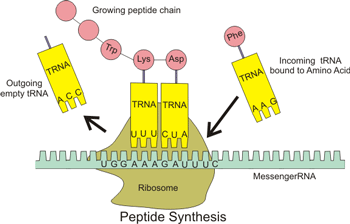
- >Top Size of Virus: ウイルスのサイズ
- Hydrogen atom: 0.1 nm (1/1000)
- Virus: 20-300 nm (200-3000)
- Adenovirus: 100 nm (1)
- Bacteria: 1000 nm=1μm (10)
- Human: 1-2 m (10M)
- Airplane: 70 m (1T)
- Cruise ship: 300 m (10T)
- Adenovirus: (icosahedral structure)
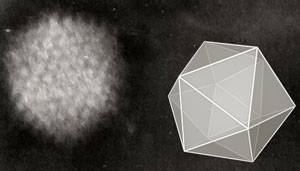
・Viral Replication: ウイルス複製
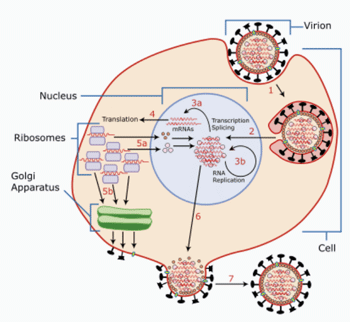
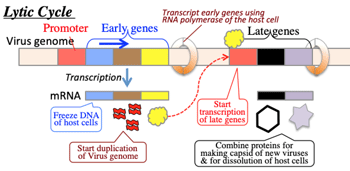
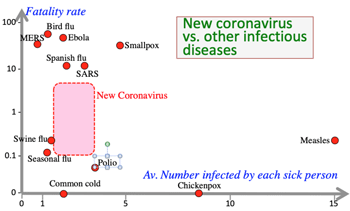
- ウイルスのBaltimore分類:
- 蛋白質合成に関わるmRNA生成による分類 (Ⅰ〜Ⅶ型)
>Top 2. Richard Dawkins describes:
- Richard Dawkins describes in 'The Greatest Show on Earth':
- A virus exists for the sole purpose of making more viruses; coded instructions with the message 'Duplicate me.'
- Three kinds of virus (>Fig.)
- On the lest, Tobacco Mosaic Virus (TMV), which parasitizes tobacco plants, or tomatoes.
- In the middle is an adenovirus, which infects the respiratory system in many animals.
- Adenovirus has exactly 252 capsomeres, arranged in an icosahedron (20 triangular faces); not by a master plan but simply by obeying the laws of chemical attraction locally when it bumps into others like itself.
- Adenovirus could be described as a very small hollow crystal.
- On the right is the T4 bacteriophage, which parasitizes bacterial, look like a lunar lander.
- In all cases viral genetic material hijacks the protein-making apparatus of the host cell and diverts its molecular production line to churning out viruses.
2. R. ドーキンスの記述:
- parasitize: 寄生する
- churn out: 大量生産
- capsomere: capsid蛋白質のsub unit
- 3 Viruses: 形態
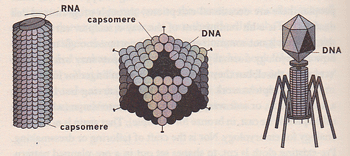
>Top 3. RNA World:
- In 1962, RNA world: by Alexander Rich
- a hypothetical stage in the evolutionary history of life: self-replication RNA molecules proliferated before the evolution of DNA.
- >Top Ribosome: is composed primarily of RNA, as the translational apparatus.
- serves as the site of biological protein synthesis (translation); link amino acids together in the order by mRNA (cellular machine reading and joining amino acids; ribosomal-RNA or rRNA).
- eukaryotic ribosomes are 25-30 nm in diameter.
- Makino Yoshihiko wrote 'The Cognitive genes (1992)"; where the RNA World is described:
- The famous question: 'Which is first, chicken or egg?'
- What about reversing of the evolutional history tape;
- First, it continues repetition of chicken-egg-chicken-egg ...
- then, chicken and egg becomes smaller quail-like chicken, and camouflage colored smaller egg.
- then chicken's wings degenerate and turns into scales, like reptiles; the environment becomes waterside and soon into underwater: it breathes with gills, and it body becomes streamlined fish.
- the fish looks like an armored fish, then change into half-transparent lancelet.
- it becomes a small nemertea of invertebrate animal, crawling about on the sea floor
- the ancestor of chicken becomes almost invisible, only unicellular organism, then prokaryotic bacteria.
- finally, the scene become yellow small cells floating in the water of the primitive earth.
- The question of chicken or egg converges into which is first, RNA or protein issue?
- Metabolic activities to support life depend on proteins as a structure.
- But nucleic acid as a template of specific protein is needed.
- And nucleic acid needs the function of catalysis of protein; and without nucleic acid self-replication is impossible.
- Miller-Urey experiment:
- In 1952, simulated the conditions thought on the early Earth and tested the chemical origin of life; actually over 20 amino acids produced in the experiments.
- The experiment used H2O, CH4, NH3 and H2, simulate lightning with heating and cooled again; and identified five amino acids such as glycine, α-alanine, and β-alanine, etc.
- >Top Abiogenesis:
Hydrothermal vent heated by geothermal energy is a favorable environment to produce nonbiotic amino acid or precursor of nucleic acid. (oligopeptide and oligonucleotide)
- Ability of self-assembly:
- 1) Mutual recognition and 2) Self-assembly matter to organize aggregation of molecules; causing less accidental errors, and more selective actions; thus Dawnism had been a fleeting vision.
- Once RNA having catalyst capacity of self-assembly happened, whose nucleic acid sequence will be dominant in number; thus a self-assembling RNA competitive world appears.
- rRNA and tRNA are located in a same gene like a family; which indicates in primitive lie, the enzyme action is included in RNA side, not in protein side.
- RNA looks like a manger (software), while protein like an engineer (hardware).
- The member of RNA world has autonomously made the system.
- >Top What about 'Protein World'?
- Polypeptide has not self-assembly ability which can be reliably inherited.
- After accidental parasitic relations of RNA and protein globules, their mutual relation has established as the life system; inheritable converge of function of protein globules (as egg) and that of RNA (as chicken)
- Purposeful cooperation of mRNA, tRNA, and rRNA.
- herein rRNA combines nucleic acid sequence and amino acid sequence.
- rRNA has anti-codon corresponding to mRNA of one side, and connector of amino acid of the other.
- Genetic code (codon): (>below list)
- set of rule to translate information encoded within DNA or mRNA; which links amino acids.
- The genetic code is similar among all organisms on Earth.
- GCC alanine
- In 1962, Alexander Rich first proposed RNA World: a hypothetical stage of evolutionary history of life on Earth.
- self-replicating RNA molecules before evolution of DNA and proteins.
3. RNAワールド:
- lancelet: ナメクジウオ
- nemertea: ヒモムシ
- self-replication: 自己複製
- enzyme: 酵素
- peptide: short chains of amino acids linked by peptide bonds. >polypeeptide
- 牧野由彦"考える遺伝子"(1992)参照
- RNA vs. DNA比較
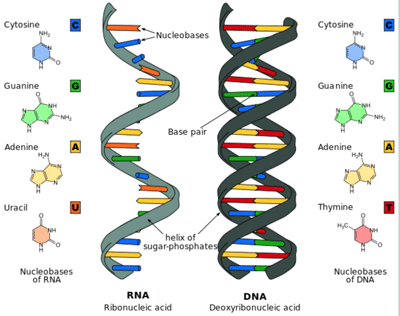
>Top 4. Standard Genetic Code:
Amino acid properties
nonpolar
polar
basic
acidic
- Lys and Arg have positive charge at neutral pH, and Asp and Glu negative charge.
1st
2nd base
3rd
U
C
A
G
U
UUU
Phe/F
UCU
Ser/S
UAU
Tyr/Y
UGU
Cys/C
U
UUC
UCC
UAC
UGC
C
UUA
Leu/L
UCA
UAA
Stop(ochre)
UGA
Stop(opal)
A
UUG
UCG
UAG
Stop(amber)
UGG
Trp/W
G
C
CUU
CCU
Pro/P
CAU
His/H
CGU
Arg/R
U
CUC
CCC
CAC
CGC
C
CUA
CCA
CAA
Gln/Q
CGA
A
CUG
CCG
CAG
CGG
G
A
AUU
Ile/I
ACU
Thr/T
AAU
Asn/N
AGU
Ser/S
U
AUC
ACC
AAC
AGC
C
AUA
ACA
AAA
Lys/K
AGA
Arg/R
A
AUG
Met/M
ACG
AAG
AGG
G
G
GUU
Vla/V
GCU
Ala/A
GAU
Asp/D
GGU
Gly/G
U
GUC
GCC
GAC
GGC
C
GUA
GCA
GAA
Glu/E
GGA
A
GUG
GCG
GAG
GGG
G
- The codon AUG both cods for methionine and serves initiation site.
- Start codon AUG (=Augment?), or stop condons (UAA=U are arrived; UAG=U are goaled; UGA (=Your goal attained).
- >Top Phosphorylation:
- this important for protein function in activating (or deactivating) about half of enzymes.
- This occures on serine, threonine, and tyrosine side chains.
- ATP (Adenosine TriPhosphate): energy exchange medium in the cell (>Fig.)
- ATP is synthesized in the mitochondrion by addition of a third phosphate group to ADP (oxidative phosphorylation)
- Kinase is an enzyme that catalyzes the transfer of phosphate groups to specific substrates.
- Photosynthesis: phosphorylation of ADP to form ATP using the sunlight energy is called photophosphorylation.
4. 標準遺伝コード:
- Oxidative phosphorylation: 酸化的リン酸化 (ATP合成)
- photophosphorylation: 光リン酸化
- Amino Acid アミノ酸
- Ala/A: Alanine
- Arg/R: Arginine
- Asn/N: Asparagine
- Asp/D: Aspartic acid
- Cys/C: Cysteine
- Gln/Q: Glutamine
- Glu/E: Glutamic acid
- Gly/G: Glycine
- His/H: Histidine
- Ile/I: Isoleucine
- Lys/K: Lysine
- Met/M: Methionine
- Phe/F: Phenylalanine
- Pro/P: Proline
- Thr/T: Threonine
- Trp/W: Tryptophan
- Tyr/Y: Tyrosine
- Ser/S: Serine
- Tyr/Y: Tyrosine
- Val/V: Valine
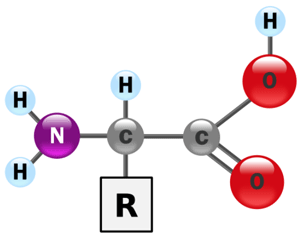
- Phosphate group: H2PO4−

>Top 5. Large DNA Viruses:
- NCLDV (NucleoCytoplasmic Large DNA Virus):
- there are nine families of NCLDV; having large genome and many genes involved in DNA repair, DNA replication, Transcription, and Translation.
- smaller viruses typically don't contain these genes.
- NCLDV replicate in both host's nucleus and cytoplasm.
- Size is from 400 nm (Ascoviridae) to around 1 μm.
- Megaviridae: linear DNA with 1.2M base pairs, which is larger than small bacteria. This virus can be found infecting acanthamoeba, whose replication cycle is taken place in the cytoplasm. (Traditionally this isgrouped into Mimiviridae)
- Pandorviridae (discovered in 2013): the largest virus, sized about 1 μm with 2.5M base pairs long (Pandoraviridae)
- Medusavirus: discovered from hot spring. Once amoeba cell falls in dormant state when infected by this virus (therefore this virus is named as Medusavirus); size is 260 nm, having 380K base pairs, rather smaller type of the group. 61% of the genes are quite new; may constitute a new family of veruses. This virus has all sets of Histon genes (H1, H2A, H2B, H3, H4), while other NCLDV's have a part of the set. Mutual hirizontal exchange of genes might have occurred between the host amoeba and this virus.
- >Top Viral Eukaryogenesis: (in 2001 by Philip Bell)
- the hypothesis that the cell nucleus of eukaryotic life evolved from a large DNA virus. The virus later evolved into the eukaryotic nucleus by acquiring genes from the host genone, eventually usurping its role.
- Giant bacteriophage assembles a nucleus-like structure tht segregates proteins.
- Viruses has not been considered as living organisms.
- But the hypothesis posits that viruses are the originators of DNA genetic mechanism shared by all eukryotes.
- Critics point out the similarities between DNA viruses and nuclei.
- Following the hypothesis, archaea, bacteria, and eukaryotes each obtained their DNA system from different viruses.
- Telomerase and telomeres, key aspects of eukaryotic ell replication, hae viral origins.
- The hypothesis points to the cell cycle of eukaryotes; sex and meiosis.
- With the virus in control of the host cell's molecular machinery, it would effecrively become a functional nucleus.
4. 巨大核質DNAウイルス: (巨大ウイルス)
- transcription: 転写
- cytoplasm: 細胞質
- viral eukaryogenesis: 細胞核ウイルス起源説
- meiosis: 減数分裂
- >Top Medusavirus:
緒方博之(京大)、武竹村政春(東京理科大) 2019/2記事
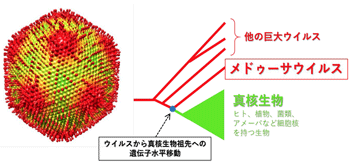
>Top 6. Report about Coronavirus (SARS-CoV-2):
- 2019/12/31: Chinese researchers identified a new virus, monitoring it to prevent the outbreak. The coronavirus can infest to human and can cause respiratory illness like SARS (Severe Acute Respiratory Syndrome) in 2003 or MERS (Middle East Respiratory Syndrome) in 2012.
- Lethality was over 2%.
- Children seem less likely to be infected.
- Men are more likely to die from an infection compared to women, possible because tobacco consumption, type-2 diabetes, high blood pressure than women.
- Bats are considered a possible source; transmitted an intermediate animal such as pangolins, passed on the virus to humans.
- People infected when they breathe, talk, cough or sneeze, allowing the virus to travel through the air.
- No drugs have been approved for any coronavirus diseases.
- It will take 3-6 months to develop a safe and effective vaccine.
- 2020/1/11: Chinese media reported the first known death of 61-year old man by the virus, who was a regular customer in Wǔhàn, Húbĕi province.
- Jan/20: WHO's first situation report; outside mainland China occurred in Japan, Korea, and Thailand.
- Jan/23: Wuhan was closed off by canceling planes and trains leaving the city; 17 people had died.
- Jan/30: WHO declared a global health emergency; US warned travelers to avoid China.
- 1/31: Trump administration suspend entry into US who traveled to China in the last 14 days.; by this date 213 people had died.
- 2/2: A 44-year man in the Philippines died after being infected; by this point, more than 360 people had died.
- 2/5: 3600 passengers in Diamond Princess cruise ship in Yokohama began a quarantine.
- 2/7: Chinese Dr. Li Wenliang died after contracting the coronavirus.
- 2/10: The death toll (908) in China surpassed the number SARS killed worldwide.
- 2/11: The death toll in China reached 1016.
- 2/14: France announced the first coronavirus death (80-year-old man) in Europe.
- 2/17: China was reviewing its trade and consumption of wildlife; as probable source of the outbreak.
- 2/19: After 14 day-quarantine, 443 passengers began leaving the cruise ship; total 621 people were infected.
- 2/21: A secretive church is linked to outbreak in Korea.; Iran announce two patients had died.
- 2/23: Italy grew to more than 150.
- 2/24: Iran emerges as a second focus point of the virus; 12 deaths.
- 2/26: Brazil tested positive for a traveler to Italy; the first case in Latin America.
- 3/1: Nearly 89,000 were infected in 65 countries, including China 80K+, Korea 4200, Italy 1,600, Iran 900, Japan 900; almost 3,000 had died.
- 3/11: WHO declared the coronavirus (COVD-19) became pandemic disease worldwide, counting the infected people are 118K, the dead 4,292, including Italy, Iran, Korea as well as China; even in US the dead became 29.
5. コロナウイルス関連ニュース:
- ウイルス伝播の経緯
- NY Times誌など詳細報道あり
>Top 7. Feature of Coronavirus (COVD-19):
- Dr. Tatsuhiko Kodama of Tokyo Univ. analyses as follows. (as of 2020/3/17 by YouTube)
- The typical data was obtained from the cruse ship (Diamond Princess); 700 people were infected, 30 intensively cared at ICU, and 7 were dead.
- Gene of the virus was analyzed in 10 days, which enabled to prepare inspection kit within a fortnight.
- >Top The world biggest companies of BGI (Beijing Genomics Institute established in 1999) and Roche (in 1896) started PCR (Polymerase Chain Reaction) inspection.
- BGI succeeded to read gene of the virus in 10 days and prepared inspection system in fortnight by mid Jan. 2020; and Roche followed it a week later.
- WHO says that more inspection and isolation matter; vaccine and antivirus agent are still under developing.
- The cruise ship Diamond Princess had an infected person by the end of Jan. 2020, but thereafter continued to voyage visiting Okinawa and Yokohama.
- >Top In Wǔhàn, two isolation hospitals having each 1000-bed with HEPA (High Efficiency Particulate Air Filter) filtered rapidly constructed within 10 days.
- While in Japan, on Feb. 8, Japanese NIID (National Institute Infectious Diseases) tried to make own inspection kit.
- >Top It is important that the Precision Medicine has drastically changed the global medicine; collecting each medical data by smartphone, after the completion of gene information in 2000.
- Pīng Ān Insurance of China retains 300M medical information ('Good Doctor') developed by $8B R&D; and Google, Amazon, or JP Morgan retains 1.3M.
- In infected cluster areas, 540K PCR Inspections were done mobilizing 54K medical staff; similarly huge inspections, individual GPS tracking, and perfect isolation were done in Korea, Taiwan, and Singapore.
- These inspection clarified that most infections occurred within family.
- The way of inspection was via digestive tract and respiratory tract.; it should have avoided to collect questionnaire sheet in a cruise ship to prevent contact infection.
- Comparison of infection:
- Japan, US, and UK are exceptionally low; 5 per 1M compared to 50-200 per 1M in other countries.
- In second week in Mar., 7893 people applied to get inspection, but only 310 could be inspected (96% applicants were rejected).
- Total infection cases: >Fig.
- in US, notorious Grand Princess with casino cruise ship returned from Hawaii increased the number of infection; such cruise ships were notorious by repeating 300-600 norovirus infection and dumping huge garbage in the ocean during 2002-2014, which was fined $4B by US court.
- >Top The inspection method of BGI and Riche are superior than US CDC (Centers for Disease Control and Prevention) or NIID in having more robust inspection depending on detailed gene information.
- UK and Japanese universal insurance functioned positively in the inspection procedure.
- >Top Patients with severe pneumonia need ECMO (Extracorporeal Membrane Oxygenation) attachment.
- Risk management:
- School closure is not effective to prevent infection; children tend to be infected by parent or adults; avoiding traffic in rush hour is more effective.
- Omission or equivocation by the message of top leaders should be avoided.
- >Top Collective care for severe patients; preventing hospital infection, preparing enough number of protective clothing, face mask, and N95 mask (Particulate Respiratory Type N95).
- Rule of use of personal data: utilization of big data with anonymity is indispensable; who, how and where infected, age, gender, belonged company, and hospital.
7. コロナウイルスの特徴:
Country
total inspected
cases
total deaths
total
cases/M
World
1,014,943
53,166
130.2
US
244,877
6,070
740
Italy
115,242
13,915
1,906
Spain
112,065
10,347
2,397
Germany
84,794
1,107
1,012
China
81,589
3,318
57
France
59,105
5,387
905
Iran
50,468
3,160
601
UK
33,718
2,921
497
Japan
2,617
63
21
India
2,543
72
2
Singapore
1,049
4
179
- Source: T.Kodama 2020/04/03
Comment
- As of 2020/2/27 Japanese Government strongly required to close all elementary, junior & senior high schools in Japan. (This instruction doesn't seem so effective.)
- During this long temporary closure, it is worth thinking about science of viruses; such as origin, evolution and function, etc.; not only paying attention to infection prevention measures.
- 2020/2/25に日本政府は全国小中高校の休校要請を出した。
- この長期に臨時休校の間に、感染防止だけでなく、ウイルスの発生・進化・機能の科学について考える意義がある。
| Covid-19 | What is Virus? |
Cat: SCI |
|
Compiled by Kanzo Kobayashi |
20303u |
Title |
What is Virus? |
ウイルスあれこれ |
Index |
||
Tag |
; Abiogenesis; ATP; Baltimore classification; Capsid; CDC; ECMO; Genetic code; Kinase; Large DNA virus; Lysis; Lysogenic cycle; Lytic cycle; Medusavirus; N95 mask; Phosphorylation; Photophosphorylation; Protein world; Ribosome; Rickettsia; RNA world; Self-assembly; Size of Virus; Structure of Virus; Viral entry; Viral eukaryogenesis; Viral replication; Virion; Viroid; | |
Original resume |
Remarks |
|
>Top 0. Preface:
|
1. 序文:
|
>Top 1. Wikipedia describes:
|
1. ウイルス (Wikipedia記述)
・Viral Replication: ウイルス複製
|
>Top 2. Richard Dawkins describes:
|
2. R. ドーキンスの記述:
|
>Top 3. RNA World:
|
3. RNAワールド:
|
>Top 4. Standard Genetic Code:
|
4. 標準遺伝コード:
|
|||||||||||||||||||||||||||||||||||||||||||||||||||||||||||||||||||||||||||||||||||||||||||||||||||||||||||||||||||||||||||||||||||||
>Top 5. Large DNA Viruses:
|
4. 巨大核質DNAウイルス: (巨大ウイルス)
|
>Top 6. Report about Coronavirus (SARS-CoV-2):
|
5. コロナウイルス関連ニュース:
|
>Top 7. Feature of Coronavirus (COVD-19):
|
7. コロナウイルスの特徴:
|
||||||||||||||||||||||||||||||||||||||||||||||||||||||
Comment |
|
|
|||||||||||||||||||||||||||||||||||||||||||||||||||||